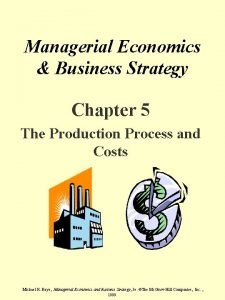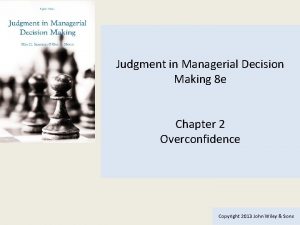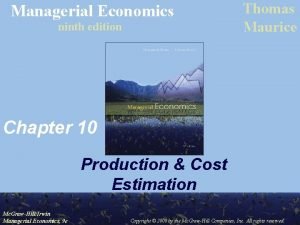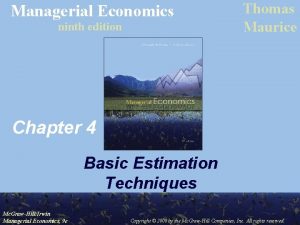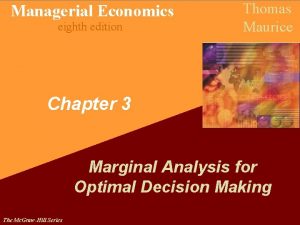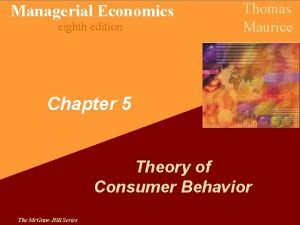Managerial Economics ninth edition Thomas Maurice Chapter 7

















- Slides: 17

Managerial Economics ninth edition Thomas Maurice Chapter 7 Demand Estimation & Forecasting Mc. Graw-Hill/Irwin Managerial Economics, 9 e Copyright © 2008 by the Mc. Graw-Hill Companies, Inc. All rights reserved.

Managerial Economics Direct Methods of Demand Estimation • Consumer interviews • Range from stopping shoppers to speak with them to administering detailed questionnaires • Potential problems § § § 2 Selection of a representative sample, which is a sample (usually random) having characteristics that accurately reflect the population as a whole Response bias, which is the difference between responses given by an individual to a hypothetical question and the action the individual takes when the situation actually occurs Inability of the respondent to answer accurately

Managerial Economics Direct Methods of Demand Estimation • Market studies & experiments • Market studies attempt to hold everything constant during the study except the price of the good • Lab experiments use volunteers to simulate actual buying conditions • Field experiments observe actual behavior of consumers 3

Managerial Economics Empirical Demand Functions • Demand equations derived from actual market data • Useful in making pricing & production decisions • In linear form, an empirical demand function can be specified as 4

Managerial Economics Empirical Demand Functions • In linear form • b = Q/ P • c = Q/ M • d = Q/ PR • Expected signs of coefficients • b is expected to be negative • c is positive for normal goods; negative for inferior goods • d is positive for substitutes; negative for complements 5

Managerial Economics Empirical Demand Functions • Estimated elasticities of demand are computed as 6

Managerial Economics Nonlinear Empirical Demand Specification • When demand is specified in log-linear form, the demand function can be written as 7

Managerial Economics Demand for a Price-Setter • To estimate demand function for a price-setting firm: • Step 1: Specify price-setting firm’s demand function • Step 2: Collect data for the variables in the firm’s demand function • Step 3: Estimate firm’s demand using ordinary least-squares regression (OLS) 8

Managerial Economics Time-Series Forecasts • A time-series model shows how a timeordered sequence of observations on a variable is generated • Simplest form is linear trend forecasting • Sales in each time period (Qt ) are assumed to be linearly related to time (t) 9

Managerial Economics Linear Trend Forecasting • If b > 0, sales are increasing over time • If b < 0, sales are decreasing over time • If b = 0, sales are constant over time 10

Managerial Economics A Linear Trend Forecast (Figure 7. 1) Q Estimated trend line 12 Sales 7 Time 11 2012 2007 2006 2005 2004 2003 2002 2001 2000 1999 1998 1997 t

Managerial Economics Forecasting Sales for Terminator Pest Control (Figure 7. 2) 12

Managerial Economics Seasonal (or Cyclical) Variation • Can bias the estimation of parameters in linear trend forecasting • To account for such variation, dummy variables are added to the trend equation • Shift trend line up or down depending on the particular seasonal pattern • Significance of seasonal behavior determined by using t-test or p-value for the estimated coefficient on the dummy variable 13

Managerial Economics Sales with Seasonal Variation (Figure 7. 3) 2004 14 2005 2006 2007

Managerial Economics Dummy Variables • To account for N seasonal time periods • N – 1 dummy variables are added • Each dummy variable accounts for one seasonal time period • Takes value of 1 for observations that occur during the season assigned to that dummy variable • Takes value of 0 otherwise 15

Managerial Economics Effect of Seasonal Variation (Figure 7. 4) Qt Qt = a’ + bt Sales Qt = a + b t a’ c a t Time 16

Managerial Economics Some Final Warnings • The further into the future a forecast is made, the wider is the confidence interval or region of uncertainty • Model misspecification, either by excluding an important variable or by using an inappropriate functional form, reduces reliability of the forecast • Forecasts are incapable of predicting sharp changes that occur because of structural changes in the market 17
 Managerial economics 12th edition mark hirschey
Managerial economics 12th edition mark hirschey Levels of analysis psychology
Levels of analysis psychology Mankiw macroeconomics 9th edition
Mankiw macroeconomics 9th edition Anatomy and physiology ninth edition
Anatomy and physiology ninth edition Psychology ninth edition david g myers
Psychology ninth edition david g myers Social psychology ninth edition
Social psychology ninth edition Biology ninth edition
Biology ninth edition Laura e berk child development (9th edition pdf)
Laura e berk child development (9th edition pdf) Berk 2013 child development
Berk 2013 child development Lysanx
Lysanx Psychology ninth edition in modules
Psychology ninth edition in modules David myers psychology 9th edition
David myers psychology 9th edition Biology ninth edition
Biology ninth edition Campbell ninth edition
Campbell ninth edition Ecomics
Ecomics Discounting principle in managerial economics
Discounting principle in managerial economics Scope and nature of managerial economics
Scope and nature of managerial economics Judgment in managerial decision making 8th edition
Judgment in managerial decision making 8th edition














